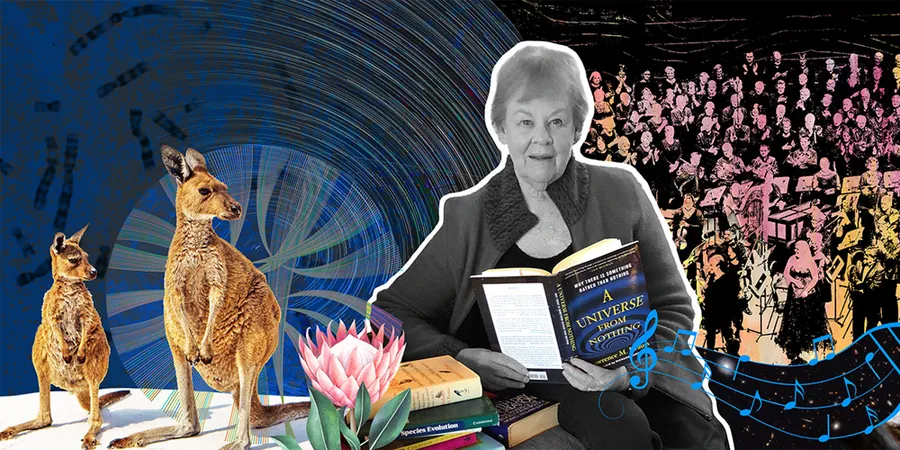
The Intersection of Science and Art: Jenny Graves' "Origins"
2025-01-01
Author: Wei
Introduction
In a revolutionary fusion of science and music, evolutionary geneticist and choral enthusiast Jenny Graves has presented a fresh perspective on creation—one that is not rooted in the Biblical narrative, but rather in the revelations of modern science. After performing Haydn’s renowned oratorio, "The Creation," numerous times, Graves grew restless with recounting the tales of Adam and Eve. Instead, she sought to craft a secular narrative detailing the origins of life through the lens of cosmology, molecular biology, evolutionary genetics, ecology, and anthropology. Her endeavor culminated in a 110-minute choral work titled "Origins of the Universe, of Life, of Species, of Humanity."
The Concept of "Origins"
"Origins" is as bold and intellectually stimulating as its creator. One of its more notable lines, 'No cosmic hand guides diversity,' elicited mixed reactions during rehearsals. While some choristers clamored for poetic ambiguity, Graves stood firm on her scientific grounding, asserting, 'I want the origin from science — and science is what I’m going to use.' This no-nonsense approach stirred controversy but ultimately won her audience; the opulent concert hall in Melbourne overflowed with applause, awarding her a standing ovation.
Jenny Graves: A Journey in Genetics
Graves’ journey into the realm of genetics began in her childhood in Adelaide, South Australia—where her parents cultivated a scientific environment. Yet initially resistant to the subject, it was a lesson on budgerigars that ignited her passion for genetics. This spark led her to pursue a degree in genetics at the University of Adelaide, where she conducted groundbreaking research on sex-determining chromosomes in kangaroos. Her ambitions soon led her to the United States under a Fulbright grant to pursue her PhD at Berkeley during the vibrant 1960s.
A Blend of Science and Music
Amid social upheaval and protest movements, Graves combined her scientific pursuits with her love for music—meeting her husband while performing in a playful take on "West Side Story" called "NucleoSide Story." Together, they shared a reverence for music that mirrored their scientific journeys.
Comparative Genomics and Challenges
A significant chapter in Graves’ research unfolded as she returned to Australia and became an architect of comparative genomics—her path diverging sharply from established norms in genetic science. In a bold challenge to Ohno's law, which posited the invariance of the mammalian X chromosome, she demonstrated that humans and kangaroos had different genetic architectures. This breakthrough not only highlighted the diversity of genetic expression among species but also laid the foundation for a burgeoning field of study that has reshaped our understanding of evolutionary relationships.
Resilience and Advocacy
However, Graves’ journey was not without trials. A harrowing cerebral hemorrhage in 1992 tested her resilience, as she battled through rehabilitation to continue her research and advocacy for women's representation in science—a narrative she continues to embody as she mentors young scientists today.
Provocative Predictions
Graves is not only a scientific pioneer but also known for her provocative statements about the future of the Y chromosome. Predicting its eventual obsolescence sparked widespread discussion and concern. Her groundbreaking explorations extended to research revealing the role of environmental factors in sex determination in reptiles, like the bearded dragon, as well as the uncharted complexity of the platypus' sex chromosomes.
Contributions to Science
In recent years, her work reached new heights when she contributed to the Earth Biogenome Project, emphasizing the need for a comprehensive understanding of all living species on the planet. Her compelling presentations resonate with audiences, catalyzing financial commitments to unprecedented scientific discoveries.
"Origins": A Musical Masterpiece
Graves’ latest magnum opus, "Origins," illustrates the elegance and complexity of scientific inquiry, transforming dense biological concepts into a vibrant auditory experience. A poignant moment in the piece recognizes Rosalind Franklin's contributions to DNA research, reclaiming her narrative from the shadows of historical oversight.
Looking Ahead: Legacy and Vision
As Graves reflects on her legacy, she wishes for "Origins" to transcend time—allowing future generations to engage with the beauty of science through music. She believes that her creative pieces hold a unique power, stating, 'If I hadn’t written ‘Origins,’ nobody else would have,' and reiterating the intrinsic connection between creativity and scientific discovery.
Conclusion
Jenny Graves stands as a testament to the power of interdisciplinary work, where the realms of science and the arts converge to narrate the human experience. Her work not only redefines the narratives around origins but also beckons others to embrace the interconnectedness of knowledge in our rapidly evolving understanding of life’s mysteries.
 Brasil (PT)
Brasil (PT)
 Canada (EN)
Canada (EN)
 Chile (ES)
Chile (ES)
 Česko (CS)
Česko (CS)
 대한민국 (KO)
대한민국 (KO)
 España (ES)
España (ES)
 France (FR)
France (FR)
 Hong Kong (EN)
Hong Kong (EN)
 Italia (IT)
Italia (IT)
 日本 (JA)
日本 (JA)
 Magyarország (HU)
Magyarország (HU)
 Norge (NO)
Norge (NO)
 Polska (PL)
Polska (PL)
 Schweiz (DE)
Schweiz (DE)
 Singapore (EN)
Singapore (EN)
 Sverige (SV)
Sverige (SV)
 Suomi (FI)
Suomi (FI)
 Türkiye (TR)
Türkiye (TR)
 الإمارات العربية المتحدة (AR)
الإمارات العربية المتحدة (AR)